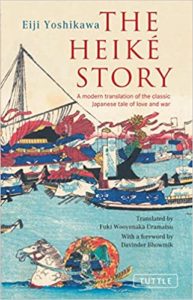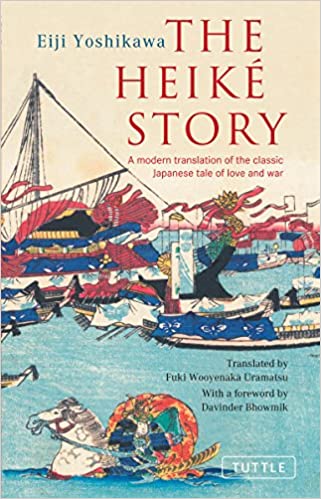


Mini-Review by Amy Chavez
The opening words to the Tales of the Heike are known to every Japanese person: “The temple bell echoes the impermanence of all things. The colors of the flowers testify to the truth that those who flourish must decay. Pride lasts but a little while, like a dream on a spring night. Before long the mighty are cast down and they are as dust before the wind.”
The Heike Story is about the ephemerality of our world in love, power and life. This story, though written in the early 1950’s, is an abridged version, or rather interpretation, of the much longer ancient tale. It’s better to think of this book as a series of short stories that are all connected. With the frequent story breaks, plot and setting changes and revolving characters, it seems to hold together better as separate parts of a whole than trying to thread one long epic tale and attempt to hold readers’ interest. I also enjoyed the focus on one hero, Kiyomori of the Heike, rather than a more encompassing story that would have involved multiple POV’s which could quickly become confusing with so many rivals to be dealt with. By focusing on the rise and fall of Kiyomori of the Heike, we, almost by default, understand the Genji/Minamoto side.
The writing/translation is beautiful and each chapter (or story) begins and ends with poetic, seasonal references such as:
“The moon was rising over the Eastern Hills, and the waters of the Kamo River took on the sheen of pearls.”
or
“The winter sea darkened slowly, taking on the indigo iridescence of fish scales as the sun dropped toward the horizon.”
Anyone who loves Kyoto will appreciate this book for all its references: the Fifth Avenue Bridge, Shirakawa, Kiyomizu Temple, Ninnaji Temple, Rokuhara, Fushimi Shrine, Mt. Hiei, Rashomon Gate and many other locations will take on much more meaning after reading this story. Anyone in Western Japan should also be interested in the stories that surround those parts, including the Seto Inland Sea.
I thought the translation was lovely, although I do wonder what “dancing girls” and “soccer” would have been in Japanese.
About the Author
Eiji Yoshikawa (1892-1962) was a Japanese historical novelist. Among his best-known novels, most are revisions of older classics. He was mainly influenced by classics such as The Tale of the Heike, Tale of Genji, Outlaws of the Marsh, and Romance of the Three Kingdoms, many of which he retold in his own style. He was awarded the Cultural Order of Merit in 1960, the Order of the Sacred Treasure, and the Mainichi Art Award just before his death in 1962. He is cited as one of the best historical novelists in Japan.
